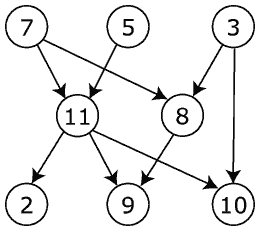I am trying to find a fast algorithm with modest space requirements to solve the following problem.
For each vertex of a DAG find the sum of its in-degree and out-degree in the DAG's transitive closure.
Given this DAG:

I expect the following result:
Vertex # Reacability Count Reachable Vertices in closure
7 5 (11, 8, 2, 9, 10)
5 4 (11, 2, 9, 10)
3 3 (8, 9, 10)
11 5 (7, 5, 2, 9, 10)
8 3 (7, 3, 9)
2 3 (7, 5, 11)
9 5 (7, 5, 11, 8, 3)
10 4 (7, 5, 11, 3)
It seems to me that this should be possible without actually constructing the transitive closure. I haven't been able to find anything on the net that exactly describes this problem. I've got some ideas about how to do this, but I wanted to see what the SO crowd could come up with.